Neomieweru
Op deze pagina vind je alle documenten, voordeelbundels en oefenvragen die worden aangeboden door verkoper neomieweru.
- 442
- 0
- 4
Community
- Volgers
- Volgend
446 items
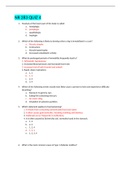
NR 283 QUIZ 4
NR 283 QUIZ 4 1. Paralysis of the lower part of the body is called: a. hemiplegia b. paraplegia. c. quadriplegia. d. Isoplegia 2. Which of the following is likely to develop when a leg is immobilized in a cast? a. Muscle atrophy b. Contracture c. Muscle hypertrophy d. Increased osteoblastic activity 3. What do prolonged periods of immobility frequently lead to? 1. Orthostatic hypotension 2. Increased blood pressure and increased heart rate 3. Increased risk of both thrombi an...
- Tentamen (uitwerkingen)
- • 4 pagina's •
NR 283 QUIZ 4 1. Paralysis of the lower part of the body is called: a. hemiplegia b. paraplegia. c. quadriplegia. d. Isoplegia 2. Which of the following is likely to develop when a leg is immobilized in a cast? a. Muscle atrophy b. Contracture c. Muscle hypertrophy d. Increased osteoblastic activity 3. What do prolonged periods of immobility frequently lead to? 1. Orthostatic hypotension 2. Increased blood pressure and increased heart rate 3. Increased risk of both thrombi an...
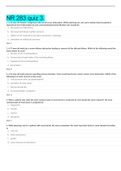
NR 283 quiz 3.
NR 283 quiz 3. 1. A 25-year-old female is diagnosed with urinary tract obstruction. While planning care, the nurse realizes that the patient is expected to have hydronephrosis and a decreased glomerular filtration rate caused by: a. Decreased renal blood flow. b. Decreased peritubular capillary pressure. c. dilation of the renal pelvis and calyces proximal to a blockage. d. stimulation of antidiuretic hormone. ANS: C 2. A 27-year-old male has a severe kidney obstruction leading to remov...
- Tentamen (uitwerkingen)
- • 12 pagina's •
NR 283 quiz 3. 1. A 25-year-old female is diagnosed with urinary tract obstruction. While planning care, the nurse realizes that the patient is expected to have hydronephrosis and a decreased glomerular filtration rate caused by: a. Decreased renal blood flow. b. Decreased peritubular capillary pressure. c. dilation of the renal pelvis and calyces proximal to a blockage. d. stimulation of antidiuretic hormone. ANS: C 2. A 27-year-old male has a severe kidney obstruction leading to remov...
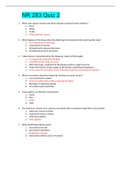
NR 283 Quiz 2
NR 283 Quiz 2 1. What color sputum would most likely indicate a bacterial chest infection? a. Clear b. White c. Frothy d. Thick yellowish - green 2. What happens in the lungs when the diaphragm and external intercostal muscles relax? a. Air is forced out of the lungs. b. Lung volume increases. c. Intrapulmonic pressure decreases. d. Intrapleural pressure decreases 3. Tuberculosis is characterized by the following: (select all that apply) a. It is spread by respiratory droplets ...
- Tentamen (uitwerkingen)
- • 3 pagina's •
NR 283 Quiz 2 1. What color sputum would most likely indicate a bacterial chest infection? a. Clear b. White c. Frothy d. Thick yellowish - green 2. What happens in the lungs when the diaphragm and external intercostal muscles relax? a. Air is forced out of the lungs. b. Lung volume increases. c. Intrapulmonic pressure decreases. d. Intrapleural pressure decreases 3. Tuberculosis is characterized by the following: (select all that apply) a. It is spread by respiratory droplets ...
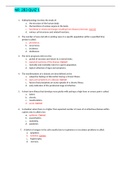
NR 283 QUIZ 1
NR 283 QUIZ 1 1. Pathophysiology involves the study of: a. the structure of the human body. b. the functions of various organs in the body. c. functional or structural changes resulting from disease processes. Correct d. various cell structures and related functions. 2. The number of new and old or existing cases in a specific population within a specified time period is called: a. prevalence. b. occurrence. c. incidence. d. abstinence. 3. The term prognosis refers to the: a. p...
- Tentamen (uitwerkingen)
- • 3 pagina's •
NR 283 QUIZ 1 1. Pathophysiology involves the study of: a. the structure of the human body. b. the functions of various organs in the body. c. functional or structural changes resulting from disease processes. Correct d. various cell structures and related functions. 2. The number of new and old or existing cases in a specific population within a specified time period is called: a. prevalence. b. occurrence. c. incidence. d. abstinence. 3. The term prognosis refers to the: a. p...
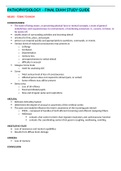
PATHOPHYSIOLOGY – FINAL EXAM STUDY GUIDE
PATHOPHYSIOLOGY – FINAL EXAM STUDY GUIDE NEURO – TERMS TO KNOW CONSCIOUSNESS • The state of being aware, or perceiving physical facts or mental concepts; a state of general wakefulness and responsiveness to environment; a functioning sensorium. [L. conscio, to know, to be aware of] • totally aware of surrounding activities and incoming stimuli • oriented to time, place, and people • person can respond quickly and appropriately to questions, commands, or events. • Various...
- Tentamen (uitwerkingen)
- • 54 pagina's •
PATHOPHYSIOLOGY – FINAL EXAM STUDY GUIDE NEURO – TERMS TO KNOW CONSCIOUSNESS • The state of being aware, or perceiving physical facts or mental concepts; a state of general wakefulness and responsiveness to environment; a functioning sensorium. [L. conscio, to know, to be aware of] • totally aware of surrounding activities and incoming stimuli • oriented to time, place, and people • person can respond quickly and appropriately to questions, commands, or events. • Various...
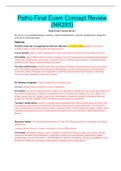
Patho Final Exam Concept Review (NR283)
Patho Final Exam Concept Review (NR283) Final Exam Concept Review Be sure to cover pathophysiology, etiology, clinical manifestations, nursing considerations, diagnostic tests for the following topics: Endocrine SIADH- Syndrome of Inappropriate Diuretic Hormone Too much ADH (antidiuretic hormone ) secretion leads to water intoxication and hyponatremia Causes include trauma, stroke, malignancies (often in the lungs or pancreas), medications, and stress S/S include signs of fluid volume over...
- Tentamen (uitwerkingen)
- • 25 pagina's •
Patho Final Exam Concept Review (NR283) Final Exam Concept Review Be sure to cover pathophysiology, etiology, clinical manifestations, nursing considerations, diagnostic tests for the following topics: Endocrine SIADH- Syndrome of Inappropriate Diuretic Hormone Too much ADH (antidiuretic hormone ) secretion leads to water intoxication and hyponatremia Causes include trauma, stroke, malignancies (often in the lungs or pancreas), medications, and stress S/S include signs of fluid volume over...
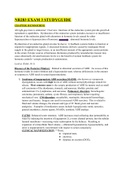
NR283 EXAM 3 STUDYGUIDE
NR283 EXAM 3 STUDYGUIDE CHAPTER 18 ENDOCRINE All right guys here is endocrine! Overview- functions of the endocrine system provide growth & reproductive capabilities. Dysfunction of the endocrine system includes excessive or insufficient function of the endocrine gland with alterations in hormone levels caused by either hypersecretion or hyposecretion of hormone abnormal hormone levels. Dysfunction of an endocrine gland can also be due to: 1) feedback systems failure t...
- Tentamen (uitwerkingen)
- • 42 pagina's •
NR283 EXAM 3 STUDYGUIDE CHAPTER 18 ENDOCRINE All right guys here is endocrine! Overview- functions of the endocrine system provide growth & reproductive capabilities. Dysfunction of the endocrine system includes excessive or insufficient function of the endocrine gland with alterations in hormone levels caused by either hypersecretion or hyposecretion of hormone abnormal hormone levels. Dysfunction of an endocrine gland can also be due to: 1) feedback systems failure t...
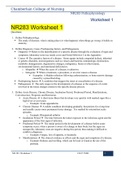
NR283 Worksheet 1
Worksheet 1 NR283 Worksheet 1 Questions: 1. Define Pathophysiology. • The study of diseases; what is taking place (or what happens) when things go wrong; it builds on anatomy. 2. Define Diagnosis, Cause, Predisposing factors, and Pathogenesis. • Diagnosis Refers to the identification of a specific disease through the evaluation of signs and symptoms, laboratory tests (see inside cover and Ready Reference 5 in the Appendix). • Causes The causative factors of a disease....
- Tentamen (uitwerkingen)
- • 13 pagina's •
Worksheet 1 NR283 Worksheet 1 Questions: 1. Define Pathophysiology. • The study of diseases; what is taking place (or what happens) when things go wrong; it builds on anatomy. 2. Define Diagnosis, Cause, Predisposing factors, and Pathogenesis. • Diagnosis Refers to the identification of a specific disease through the evaluation of signs and symptoms, laboratory tests (see inside cover and Ready Reference 5 in the Appendix). • Causes The causative factors of a disease....
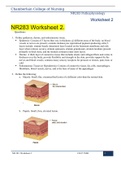
Worksheet 2 NR283 Worksheet 2.
Worksheet 2 NR283 Worksheet 2. Questions: 1. Define epidermis, dermis, and subcutaneous tissue. • Epidermis: Consists of 5 layers that vary in thickness @ different areas of the body; no blood vessels or nerves are present; contains melanocytes (specialized pigment-producing cells);5 layers include: stratum basale (innermost layer located on the basement membrane and only layer where mitosis occurs), stratum spinosum, stratum granulosum, stratum lucidum (present primarily in thick skin)...
- Tentamen (uitwerkingen)
- • 16 pagina's •
Worksheet 2 NR283 Worksheet 2. Questions: 1. Define epidermis, dermis, and subcutaneous tissue. • Epidermis: Consists of 5 layers that vary in thickness @ different areas of the body; no blood vessels or nerves are present; contains melanocytes (specialized pigment-producing cells);5 layers include: stratum basale (innermost layer located on the basement membrane and only layer where mitosis occurs), stratum spinosum, stratum granulosum, stratum lucidum (present primarily in thick skin)...
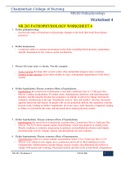
NR 283 PATHOPHYSIOLOGY WORKSHEET 4
Worksheet 4 NR 283 PATHOPHYSIOLOGY WORKSHEET 4 1. Define pathophysiology. - involves the study of functional or physiologic changes in the body that result from disease processes 2. Define homeostasis. - a relatively stable or constant environment in the body, including blood pressure, temperature, and pH, maintained by the various control mechanisms 3. Discuss the terms acute vs chronic. Provide examples. - Acute rejection develops after several weeks when unmatched a...
- Tentamen (uitwerkingen)
- • 23 pagina's •
Worksheet 4 NR 283 PATHOPHYSIOLOGY WORKSHEET 4 1. Define pathophysiology. - involves the study of functional or physiologic changes in the body that result from disease processes 2. Define homeostasis. - a relatively stable or constant environment in the body, including blood pressure, temperature, and pH, maintained by the various control mechanisms 3. Discuss the terms acute vs chronic. Provide examples. - Acute rejection develops after several weeks when unmatched a...
